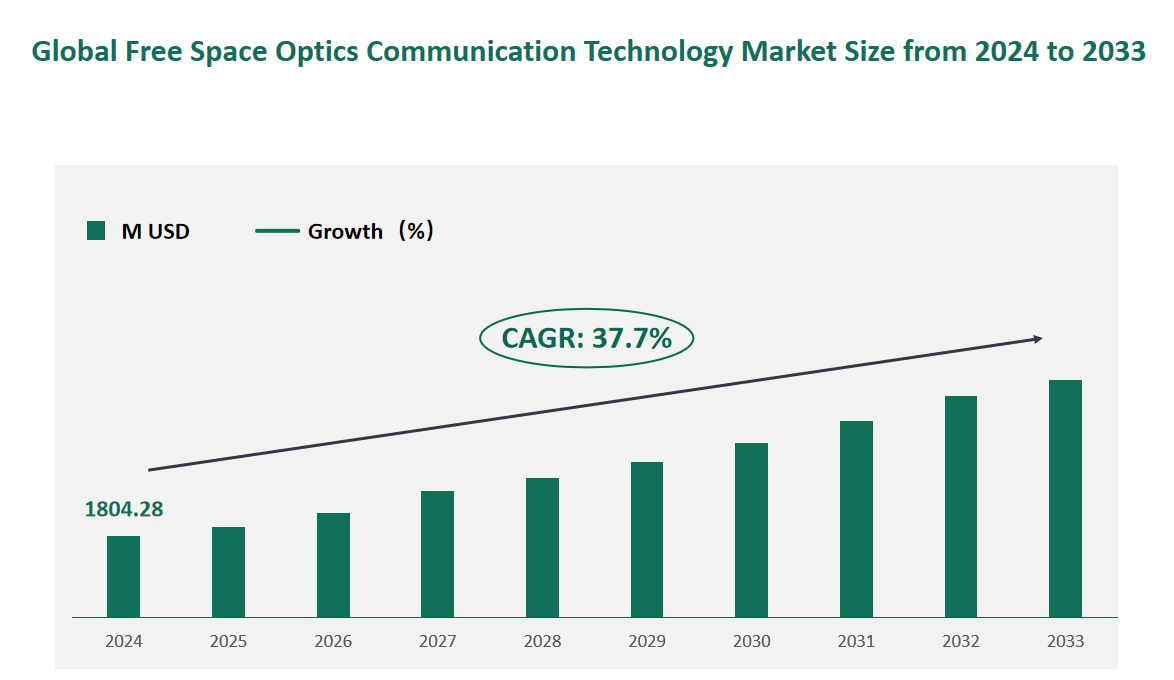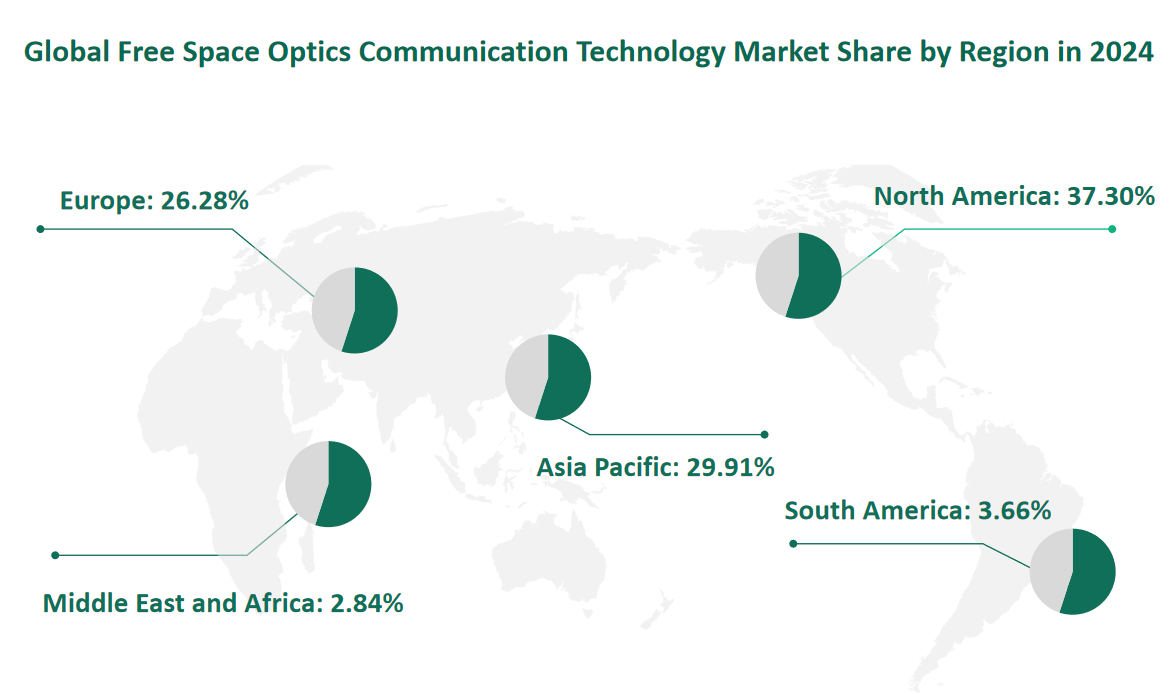1 Global Free Space Optics Communication Technology Market Size (Value) and CAGR (2024-2033)
In 2024, the global Free Space Optics Communication Technology market was valued at USD 1804.28 million, with a CAGR of 37.7% from 2024 to 2033.
Free-space optical communication (FSO) is an optical communication technology that uses light propagating in free space to wirelessly transmit data for telecommunications or computer networking. “Free space” means air, outer space, vacuum, or something similar.
Figure Global Free Space Optics Communication Technology Market Size (M USD) and CAGR 2024-2033

2 Free Space Optics Communication Technology Market Drivers
FSO technology offers several advantages over traditional communication methods. Compared to microwave technology, FSO provides higher modulation rates, wider frequency bands, and does not require spectrum licensing. Unlike wired and fiber optic communication, FSO systems are more flexible, have lower operating costs, and can be installed without the need for extensive infrastructure. These characteristics make FSO an attractive solution for various applications, including wireless base station data backhaul, last-mile access, and emergency communication scenarios.
The continuous development of laser, optics, and optoelectronic components has significantly improved the performance and reliability of FSO systems. Breakthroughs in space laser communication have been achieved by countries such as the United States, Europe, Japan, China, and Russia. China has also made significant progress in long-distance quantum communication, achieving a device-independent quantum key distribution (MDI-QKD) experiment over a distance of 19.2 km. These advancements have demonstrated the potential of FSO technology to address the “last kilometer” challenge in information transmission, making it a viable alternative to traditional communication methods.
FSO technology has a wide range of applications across various sectors. In the aerospace industry, FSO is used for satellite-to-ground and inter-satellite communications, providing high-bandwidth and low-latency data transmission. Terrestrial applications include wireless base station backhaul, last-mile access, and secure communication networks for financial, medical, and military institutions. The ability to quickly deploy FSO systems makes them ideal for temporary deployments such as concerts, expositions, construction sites, and video surveillance.
3 Free Space Optics Communication Technology Market Restraints
FSO systems require a clear line-of-sight between the transmitter and receiver, which can be a significant limitation. Obstacles such as buildings, trees, and atmospheric conditions (e.g., fog, rain, and snow) can severely impact the performance and reliability of FSO links. The need for precise alignment and the potential for beam interruptions due to environmental factors can also complicate the installation and maintenance of FSO systems.
FSO technology is highly sensitive to weather conditions, which can be a major challenge in regions with variable climates. While sunny conditions have minimal impact on FSO transmission, rain, snow, and fog can cause significant attenuation. According to tests, the attenuation value of FSO can range from 5-15 dB/km on sunny days to 50-300 dB/km in foggy conditions. This sensitivity to weather can limit the effective range and reliability of FSO systems, making them less suitable for areas with frequent adverse weather conditions.
The installation and maintenance of FSO systems can be complex and costly. High-power laser diodes, advanced optics, and multi-beam systems are often required to mitigate the effects of weather and atmospheric conditions. Additionally, the need for qualified personnel to install and maintain these systems can further increase the overall cost. The initial investment in FSO equipment can range from $3,000 to $10,000, which may be prohibitive for some potential users.
4 Global Free Space Optics Communication Technology Market Size and Share by Type in 2024
Transmitters: These devices are responsible for generating and emitting laser beams to transmit data. They convert electrical signals into optical signals that can be transmitted through the air. In 2024, the market value for transmitters is projected to be $685.25 million. Transmitters are a critical component in initiating the communication link in FSO systems, ensuring that data can be sent efficiently and securely.
Receivers: Receivers capture the transmitted laser beams and convert them back into electrical signals. They must be highly sensitive to accurately detect and decode the transmitted data, even in challenging environmental conditions. The market value for receivers in 2024 is estimated at $544.23 million. Receivers play a vital role in ensuring the integrity and reliability of the received data.
Modulators: Modulators encode data onto the laser beams by modulating the amplitude, phase, or frequency of the light. This process is essential for carrying digital information through the air. The market value for modulators in 2024 is expected to be $147.16 million. Modulators ensure that the data is accurately encoded and transmitted without errors.
Demodulators: Demodulators decode the modulated data from the received laser beams. They must be highly accurate to ensure that the received data is correctly interpreted and free from errors. The market value for demodulators in 2024 is projected to be $114.89 million. Demodulators are crucial for maintaining the integrity of the communication link.
Table Global Free Space Optics Communication Technology Market Size and Share by Type in 2024
Type | Market Size (M USD) 2024 | Market Share 2024 |
Transmitters | 685.25 | 44.74% |
Receivers | 544.23 | 35.53% |
Modulators | 147.16 | 9.61% |
Demodulators | 114.89 | 7.50% |
Others | 40.13 | 2.62% |
5 Global Free Space Optics Communication Technology Market Size and Share by Application in 2024
In 2024, the Terrestrial Platform segment is expected to hold a market value of $750.37 million. Terrestrial platforms utilize FSO technology for ground-based communication systems, including wireless base station backhaul, last-mile access, and secure communication networks for financial, medical, and government institutions. The flexibility and low installation costs of FSO systems make them an attractive solution for urban and rural areas where fiber optic cables are not available. Additionally, the ability to quickly deploy FSO systems makes them ideal for temporary deployments such as concerts, expositions, and construction sites. The increasing demand for high-speed, secure communication solutions in these areas drives the growth of this segment.
The Satellite Platform segment is projected to reach a market value of $777.19 million in 2024. Satellite platforms employ FSO technology for space-based communication systems, including satellite-to-ground and inter-satellite links. These applications are critical for high-speed data transmission in space, enabling real-time communication and data transfer between satellites and ground stations. The high bandwidth and low latency of FSO systems make them suitable for applications such as Earth observation, remote sensing, and space exploration. The increasing demand for high-speed, secure communication in space drives the growth of this segment, supported by advancements in laser and optical technologies.
The Airborne Platform segment is expected to hold a market value of $276.72 million in 2024. Airborne platforms use FSO technology for communication between aircraft and ground stations, as well as between aircraft. These systems are essential for applications such as air traffic control, military surveillance, and unmanned aerial vehicle (UAV) communication. The ability to provide high-speed, secure communication links in dynamic environments makes FSO a valuable solution for airborne platforms. The growth of this segment is driven by the increasing use of UAVs and the need for reliable communication systems in aviation.
Table Global Free Space Optics Communication Technology Market Size and Share by Application in 2024
Application | Market Size (M USD) 2024 | Market Share 2024 |
Terrestrial Platform | 750.37 | 41.59% |
Satellite Platform | 777.19 | 43.07% |
Airborne Platform | 276.72 | 15.34% |
6 Global Free Space Optics Communication Technology Market Size by Region in 2024
In 2024, the North America region is projected to hold a market value of $673.06 million. North America, comprising the United States and Canada, is a significant market for FSO technology due to its advanced technological infrastructure and high demand for high-speed communication solutions. The region is home to major aerospace and defense companies that drive the adoption of FSO systems for satellite communication and military applications.
Europe is expected to hold a market value of $474.21 million in 2024. Europe is a key market for FSO technology, driven by its strong aerospace and defense industries. Countries such as France, Germany, and the United Kingdom are at the forefront of adopting FSO systems for satellite communication and military applications. The European Union’s focus on developing advanced communication technologies and its support for space exploration initiatives contribute to the growth of this segment.
The Asia Pacific region is projected to reach a market value of $539.73 million in 2024. The Asia Pacific region is experiencing rapid growth in the FSO market, driven by increasing government investment in communication infrastructure and space exploration. Countries such as China, Japan, and South Korea are leading the adoption of FSO technology for satellite communication and terrestrial applications.
Figure Global Free Space Optics Communication Technology Market Size by Region in 2024

7 Major Players in Global Free Space Optics Communication Technology Market
7.1 Tesat Spacecom
Tesat Spacecom is a prominent player in the FSO market, known for its expertise in manufacturing communication satellite payload equipment. Established in 1949 and headquartered in Germany, Tesat Spacecom has become a leader in the European market. The company’s business overview highlights its deep involvement in the aerospace sector, providing highly reliable equipment such as traveling wave tube amplifiers, multiplexers, waveguide switches, and modulators.
These products are integral components in communication satellites, enabling the transmission of TV signals and other data globally. In terms of product and service analysis, Tesat Spacecom offers a range of laser communication terminals, including the LCT135 for high-speed data transmission over long distances and the SmartLCT for smaller, lighter satellites.
The company’s recent financial performance is impressive, with a value of $99.68 million in 2021, a gross profit of $40.61 million, and a gross margin of 40.74%.
7.2 Ball Corporation
Ball Corporation, headquartered in the USA, is another major player in the FSO market. Established in 1880, Ball Corporation is renowned for its diverse business ventures, including aerospace technology. The company’s business overview emphasizes its role in developing laser communication terminals that meet the needs of next-generation communication systems.
Ball Corporation’s products and services include GEO terminals for high data-rate backbone applications, LEO terminals for shorter-range user applications, and airborne terminals for high data-rate communication between aircraft and satellites.
The company’s recent financial performance is equally noteworthy, with a value of $67.38 million in 2021, a gross profit of $26.48 million, and a gross margin of 39.30%.
7.3 General Atomics
General Atomics is a defense and diversified technologies company that has made significant strides in the FSO market. Established in 1955 and headquartered in the USA, General Atomics is known for its extensive operations in the defense and aerospace sectors. The company’s business overview highlights its involvement in various high-tech projects, including the development of unmanned aircraft, satellite surveillance systems, and laser communication technologies.
General Atomics’ products and services in the FSO domain include Optical Communication Terminals (OCTs) that enable high-speed, secure data transmission between satellites and ground stations.
The company’s recent financial performance reflects its strong market position, with a value of $64.86 million in 2021, a gross profit of $25.40 million, and a gross margin of 39.15%.

